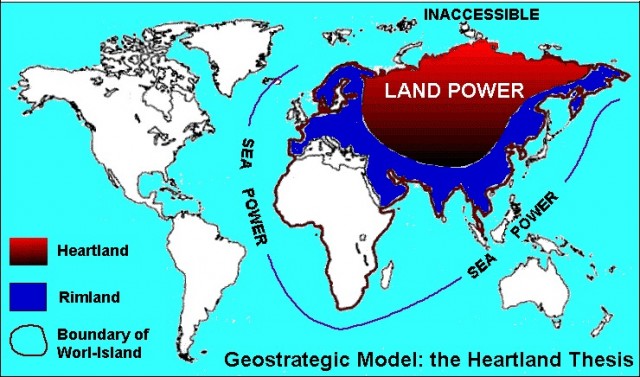heartland
THE HEARTLAND THEORY was developed by Scottish geographer, Sir Halford J. MACKINDER. He read his paper “The Geographical Pivot of History” before the Royal Geographical Society in London in 1904, and soon afterward published his views on the influence of geography on politics in the Geographical Journal.
Mackinder's argument introduced into POLITICAL GEOGRAPHY the view that the globe could develop into two power blocs. The center of world power lay in the “heartland.” This was roughly the territory east of the DANUBE RIVER to the URAL MOUNTAINS. Mackinder claimed that whoever unified and dominated Central and Eastern Europe would be able to control the three continents of the “World Island”—Europe, Asia, and Africa. His hypothesis, which became famous, was: “Who rules Eastern Europe commands the Heartland. Who rules the Heartland commands the World Island. Who rules the World Island commands the world.” The other power bloc, because of what he viewed as the relative decline of sea power, was the “maritime lands.”

Mackinder had rejected the theory of sea power as the key to world domination proposed in The Influence of Sea Power upon History by Captain Alfred T. Mahan of the U.S. Navy. Mahan developed a number of factors of state power, such as geographical position, extent of territory, population, and national and governmental character to explain state power. Mahan had used his study to propose policies for the American government to follow. These included annexing the Hawaiian Islands, controlling the CARIBBEAN SEA, and building a canal across PANAMA. Theodore Roosevelt was to use these ideas as the basis of his foreign policy.
In contrast, Mackinder claimed that land-based power was increasing in scope because of improvements in communications, transportation, and armaments. The heartland power would be the ultimate land power that would be impossible to expel from its natural fortress. He believed that there was a Eurasian core that would be impregnable to naval power. As the center of a great fertile landmass, it would be difficult to penetrate with sea power and easily defended with land forces.
Mackinder's views were read and discussed by many people immediately. His hypothesis soon became one of the most intensely debated ideas in the history of geography. Mackinder's views were eagerly accepted by a number of German politicians. In particular by Karl Haushofer, who with others adopted a geopolitik program. Their views influenced Adolf Hitler, who used them as a rationale for conquering Europe.
Among those who disagreed with Mackinder's theory was N.J. Spykman. He argued that Mackinder had exaggerated the Heartland's potential for power. The real power was not in the “pivot,” as Mackinder had termed the heartland, but in what Mackinder had called the “inner crescent” or the “rimland” in Spykman's terminology. Spykman's hypothesis became, “He who controls the Rimland rules Eurasia; Who rules Eurasia controls the destinies of the world.”
Missing from the heartland theories of Mackinder and Spykman was air power. In 1943 Mackinder dismissed air power as a technological change that would make a difference in the balance of power. However, in
1950 A.P. de Seversky argued that the key to American survival and supremacy was air power. Another critic of Mackinder was A.R. Hall. In 1955, Hall argued that Mackinder had ignored the existence of another “heartland,” namely the Anglo-American alliance.
In 1956, D.W. Meinig proposed changes to Mackinder's heartland theory and to the rimland theory. His criticism included changes to the definitions and criteria of Mackinder's theory. In 1964, D.J.M. Hooson extended the heartland theory by identifying the “core” areas, such as the industrial centers.
In the last quarter of the 20th century, two major groups debated and extended Mackinder's ideas. The first group was composed of specialists in strategic studies. One important representative of this approach was Colin S. Grey, who published The Geopolitics of the Nuclear Era (1979). The other group was composed of scholars in traditional POLITICAL GEOGRAPHY. These included authors such as Geoffrey Parker (Western Geopolitical Thought in the Twentieth Century 1985), among others.
After World War II, the Soviet Union effectively controlled the heartland. Mackinder, however, had proposed ideas of an Atlantic community in 1924 that developed into the NORTH ATLANTIC TREATY ORGANIZATION (NATO). It addition the Cold War policy of containment of communism was, in effect, a siege of “fortress” heartland. Global politics of the 20th century were deeply influenced by Mackinder's geopolitical vision. The War on Terror is also being waged with a geopolitical eye on the Middle Eastern “rimland.”